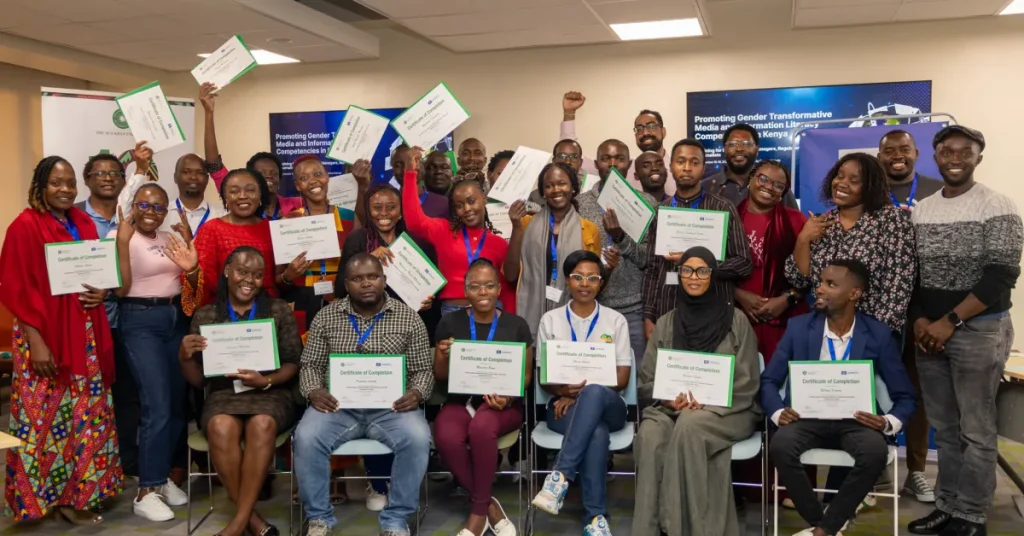Listen to the article
Kenyan newsrooms are taking significant steps to combat misinformation and promote gender inclusivity through specialized training programs, as evidenced by a recent professional development initiative for media practitioners.
The comprehensive workshop, “Promoting Gender-transformative Media and Information Literacy Competencies in Kenyan Newsrooms,” equipped journalists and editors with essential skills to navigate Kenya’s increasingly complex digital media landscape.
Participants received hands-on training in several critical areas, including fact-checking methodologies, digital content verification techniques, and media and information literacy (MIL) competencies. The program also covered platform governance dynamics, digital media ethics, gender inclusion principles, and practical case studies demonstrating MIL readiness in newsroom environments.
This initiative comes at a crucial time for Kenyan media, as the country grapples with rising concerns about online misinformation and gender-based harassment. According to recent studies, Kenya has seen a 47% increase in digital misinformation over the past two years, with women journalists disproportionately targeted by online harassment campaigns.
“The media landscape in Kenya is evolving rapidly, and newsrooms must adapt to maintain their credibility,” said Sarah Omwenga, a media analyst who has studied East African journalism trends. “This type of comprehensive training addresses both the technical and cultural aspects of modern journalism.”
A significant portion of the workshop focused on developing concrete strategies for integrating gender-transformative policies into daily newsroom operations. This approach aims to move beyond superficial inclusion efforts toward structural changes that reshape how stories are assigned, sources are selected, and content is presented.
Participants explored how these skills could be practically applied to combat harmful online content, which has become increasingly prevalent across Kenya’s digital media ecosystem. The training emphasized that gender-sensitive reporting is not merely about equal representation but requires fundamental changes in how news organizations operate.
The workshop highlighted the critical role of editorial leadership in driving these transformations. Media executives and senior editors were encouraged to champion MIL competencies as core components of journalistic practice rather than optional add-ons.
“Editorial leaders set the tone for newsroom culture and standards,” explained David Mutua, one of the workshop facilitators. “When they prioritize information literacy and gender inclusivity, it becomes embedded in the organization’s DNA rather than being viewed as a special initiative.”
The timing of this training aligns with broader regional efforts to strengthen media integrity across East Africa. Media councils in neighboring Uganda and Tanzania have recently launched similar initiatives, recognizing that public trust in journalism has eroded partly due to the proliferation of misinformation.
Industry experts note that Kenyan media organizations face unique challenges in implementing these practices. Limited resources, competitive pressures, and political sensitivities can all complicate efforts to institute rigorous verification processes and inclusive reporting frameworks.
However, participants expressed optimism about applying their newly acquired skills. “These aren’t just theoretical concepts,” noted Patricia Kimani, an editor who attended the workshop. “We received practical tools that can be immediately implemented in our newsrooms to improve our reporting accuracy and inclusivity.”
The workshop represents part of a growing recognition that media literacy and gender inclusivity are interconnected aspects of quality journalism. By addressing both simultaneously, newsrooms can build greater resilience against misinformation while better serving their increasingly diverse audiences.
As Kenya approaches its next electoral cycle, the skills developed through this initiative may prove particularly valuable in helping news organizations navigate politically sensitive coverage while maintaining public trust and countering the spread of harmful content.
Verify This Yourself
Use these professional tools to fact-check and investigate claims independently
Reverse Image Search
Check if this image has been used elsewhere or in different contexts
Ask Our AI About This Claim
Get instant answers with web-powered AI analysis
Related Fact-Checks
See what other fact-checkers have said about similar claims
Want More Verification Tools?
Access our full suite of professional disinformation monitoring and investigation tools




8 Comments
This training program for Kenyan media leaders is a critical step in combating the spread of misinformation and promoting gender inclusivity in the industry. Fact-checking and digital verification skills are essential tools in the modern media landscape.
Agreed. Equipping journalists with the right competencies to navigate these complex challenges will help strengthen the integrity and credibility of Kenyan news coverage.
This initiative highlights the importance of ongoing professional development and capacity-building for media leaders, particularly in the areas of fact-checking, digital verification, and media and information literacy. It’s a model that could potentially be replicated in other countries facing similar challenges.
It’s encouraging to see Kenyan newsrooms taking concrete steps to strengthen their ability to combat misinformation. The focus on digital verification techniques and platform governance dynamics is particularly relevant in today’s rapidly evolving media landscape.
The rising concerns around online misinformation and targeted harassment of women journalists in Kenya are deeply concerning. This initiative seems like a proactive and necessary response to address these pressing issues.
Absolutely. Enhancing media and information literacy is crucial to empowering journalists and fostering a more trustworthy and inclusive media environment.
The statistics around the increase in digital misinformation in Kenya are quite alarming. This training program appears to be a timely and well-rounded effort to equip media practitioners with the necessary skills to navigate these challenges.
I agree. Addressing gender-based harassment is also a critical component, as it can undermine the ability of women journalists to report effectively and safely.